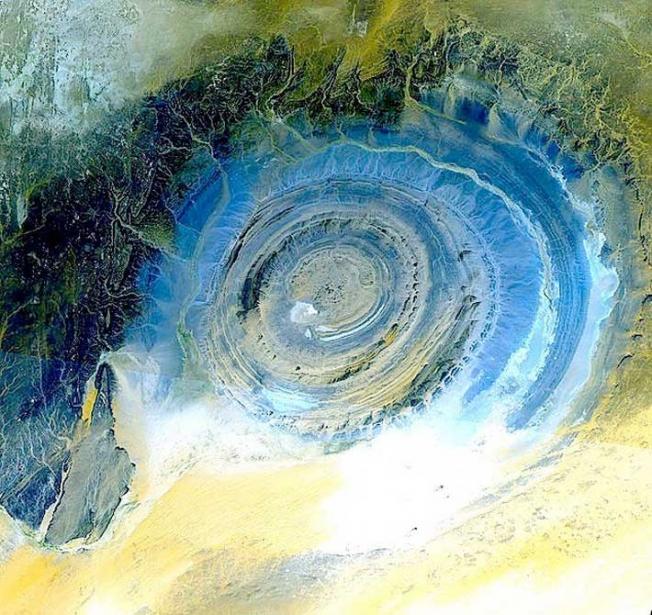
The common name for the landmark and circular feature with a diameter of 40km is The Richat Structure. However, everyone know the feature in Mauritania as the Giant Eye of Africa. Located in the Sahara Desert, the sedimentary rocks of the structure come from different eras, ranging from the age of Late Protrozoic to Ordovician sandstone.
Understanding the mystery
Let’s try break down the structure of the circular feature known as the Giant Eye of Africa. The interior of the Richat Structure consists of extrusive and intrusive igneous rocks. The variety of rocks include: kimberlites, rhyolitic volcanic rocks (lava flows and hydrothermally rocks), carbonatites and gabbros.
The feature is constructed from two distinct eruptive centers. Field mapping shows that the gabbroic rocks in the Richat Structure form two concentric ring dikes. The inner ring with a width of 20m is located 3 km from the center of the feature. The outer ring has a width of 50m and lies 8 km from the center of the structure.
The Richat Structure contains more than 32 carbonatite dikes which are 1 to 4 meters wide and 300 meters long. According to researches, the carbonatite rocks in the Richat Structure date back to 104 million years ago.
In the northern part of the Giant Eye, scientists have found kimberlitic plug that is believed to be 99 million years old.
Aside from rocks, hydrothermal features are also part of the Giant Eye in the Sahara desert.
When it was first discovered, the Giant Eye of Africa was considered an asteroid impart structure. The reasoning behind the theory is that the high degree of circularity could be a result of an asteroid impact. However, nowadays, scientists argue that the feature is symmetrical and deeply eroded geological dome. A recent study argues that the carbonates in the Richat Structure were created by hydrothermal waters with low temperature. However, no matter what people believe, every scientist out there is certain in one thing: the Giant Eye of Africa needs protection and requires a deeper and more analytical research of its origin.
Plato’s view
One of the theories regarding the Richat Structure is that it actually represents the lost city of Atlantis described by Plato in his works.
Plato described the mysterious island as a circular piece, divided into circles of both water and land. According to Plato, there were 3 circles of water and 2 circles of land. He positioned the Atlantis as a landmark lying in front of the Pillars of Hercule.
IMG-R:http://www.daviddarling.info/images/Plato_Atlantis_reconstruction.jpg;
The Atlantis represents the power of the Ancient Athens, and is considered the land for Plato’s ideal state. In the story of Atlantis, Plato says that Athens was able to repel the attack from forces in the Atlantic ocean, and was the only nation in the Western (then known) world to do so. However, due to earthquakes, the island submerges into the Atlantic Ocean as Gods decide to leave the spot.
Plato also referenced a mountain sheltering the city. Coincidentally, a quick study of the area surrounding the Giant Eye shows high, mountainous ridge to the north.
IMG-L:http://www.gigalresearch.com/uk/images/Giant-blue-eye-Mauritania/Giant-blue-eye-mauritania-02.jpg;
View from space
Because of its size, the Giant Eye is considered a landmark so big, that early space missions used it to navigate. Early space missions used the Richat Structure as a landmark, and nowadays, the place is still seen as a landmark on Google Earth. There have also been pictures taken by NASA from space stations trying to capture the beauty and the mystery of the place.
The size of the formation, that it wasn’t until space pioneers noticed it while they were flying in the orbit over Africa.

Will you believe if we tell you that animals might be even better engineers than humans? We pride ourselves in being great engineers. We build some amazing buildings. We have...
People try to raise awareness in a different way. We all have our ways for raising awareness. Some organize public events. Some make donations. And some go on a trip. Andr...
31 years ago, NASA experienced one of the greatest disasters in the history of the space program. The space shuttle Challenger broke apart just 73 seconds into the flight.The disas...
World leaders met in Paris in December 2015 to discuss climate change and how it affects all of us. The leaders struck out a historic agreement. Prior to the meeting, Paul...